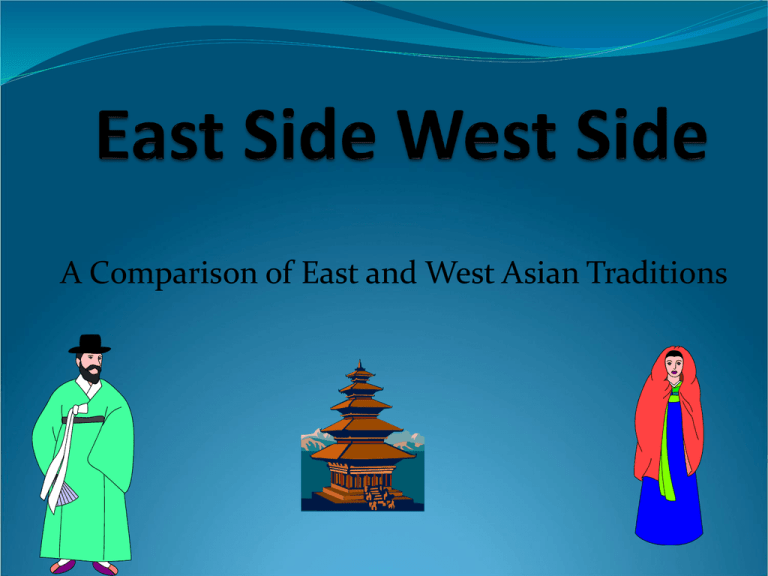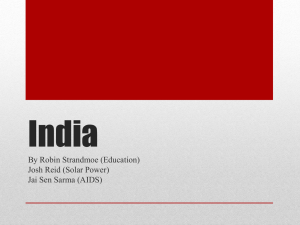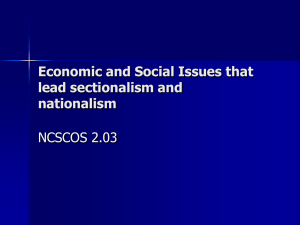PPT Link
advertisement

A Comparison of East and West Asian Traditions Countries of West Asia Turkey, Cyprus, Israel, Jordan, Syria, Lebanon, Iraq, Kuwait, Bahrain, Qatar, Saudi Arabia, Yemen, United Arab Emirates, Oman, Georgia, Armenia, Azerbaijan, Iran, Kazakhstan, Uzbekistan, Turkmenistan, Afghanistan, Pakistan, Kyrgyzstan, Tajikistan, India, Nepal, Bhutan, Bangladesh, Sri Lanka, and Russia Traditions Traditions are ways of doing things that one generation hands down to the next. West Asia contains many ancient sites, such as the Old City of Jerusalem, where traditions of Judaism, Christianity, and Islam are important. The Old City in Jerusalem Armenian Quarter http://en.wikipedia.org/wiki/Old_City_(Jerusalem) Christian Tradition In Jerusalem The Church of the Holy Sepulchre Today the Church of the Holy Sepulchre stands on the site where tradition says that Jesus was crucified and buried. http://holysepulchre.com/ Jewish Tradition In Jerusalem The Western Wall The Western Wall was once part of the walls surrounding the Second Temple that was destroyed by the Romans in A.D. 70. Jewish people write prayers on pieces of paper and place them in the cracks between the stones of the wall. http://en.wikipedia.org/wiki/File:Western_wall_jerusalem_night.jpg Hurva Synagogue http://image56.webshots.com/156/2/61/41/393326141IaKYHG_ph.jpg The Hurva Synagogue, located in the Jewish Quarter of Jerusalem, has been repeatedly destroyed and rebuilt over many years. All that stands today is one of the synagogue’s arches. Muslim Tradition In Jerusalem The Dome of the Rock http://en.wikipedia.org/wiki/Dome_of_the_Rock The Dome of the Rock was built over a rock from which Muslims believe Muhammad, the founder of Islam, ascended into heaven. Pilgrimage to Mecca, Saudi Arabia Mecca, Muhammad’s birthplace, is the holiest city in Islam. Five times a day, wherever they are all over the world, religious Muslims turn towards Mecca to pray. Most Muslims try to make a pilgrimage or “hajj” to Mecca at least once in their lifetimes. Inside the Great Mosque is the Kaaba, which contains the Black Stone of Mecca. Some Muslims believe God gave this stone to the first man, Adam. The ancient city of Petra Petra is located in a valley of Jordan. Buildings were carved into the rock of the mountains that surround Petra. After an earthquake destroyed most of the city in A.D. 551, Petra’s population declined and it became home to only a very small community. http://en.wikipedia.org/wiki/File:Petra_Jordan_BW_21.JPG Bukhara, Home of the Kalon Mosque & Minaret Unlike many ancient cities, people still live in Bukhara. Bukhara is located in what is now the country of Uzbekistan. One of the most beautiful buildings in the city is the Kalon Minaret, built in the 1100s. A minaret is a tower attached to a mosque from which Muslims are called to prayer. http://en.wikipedia.org/wiki/File:Bukhara01.jpg Hatra, Fortress City http://www.atlastours.net/iraq/hatra.html This ancient city is located in present day Iraq. It was built about 400 B.C. as a fortress, a place protected from attack. Hatra has outer and inner walls that helped stop several Roman invasions until Shapur I, king of Persia, destroyed it in about A.D. 240. Masada, Desert Fortress Overlooking the Dead Sea http://www.jewishvirtuallibrary.org/jsource/Archaeology/Masada1.html This ancient city stands on a cliff in Israel. Its high location made it a natural fortress. Around 35 B.C., King Herod built walls around Masada to protect it even more. The Ganges, India’s Sacred River http://www.abigailsarah.co.za/myart/tantra/tantra_pics/river_ganges.jpg Facts about the Ganges It flows through northern India and Bangladesh. The Hindus believe this river to be sacred. Hindus who live close to the river drink and bathe in it every day. When a Hindu dies, family members take the body to be cremated and hold a special ceremony sprinkling the ashes in the river. The water of the Ganges is believed to end the cycle of reincarnation, allowing a person finally to go to heaven. Travelers to the Ganges often take water home in containers to be worshipped at their local temples. Taj Mahal, Agra, India http://en.wikipedia.org/wiki/Taj_Mahal Shah Jahan, the leader of the Mughal Empire, had the Taj Mahal built in memory of his wife. It took 20,000 workers from 1631 to 1648 to finish this magnificent building. Countries of East Asia http://geology.com/world/asia-map.gif Mongolia, China, Myanmar (Burma), Laos, Thailand, Cambodia, Vietnam, Malaysia, Singapore, Brunei, Indonesia, North Korea, South Korea, Japan, Taiwan, Philippines, and Russia Traditions Traditions are ways of doing things that one generation hands down to the next. In East Asia, kite flying is an ancient tradition that started at least 3,000 years ago. Japanese Kite Flying http://kiteclub.org/pages/festival.htm The Hamamatsu Kite Festival tradition dates back to the 1500s, when a large kite was flown to honor the birth of a Japanese prince. Yet the importance of the kites in Japanese culture dates back even further. Kites may have been invented in China about 3,000 year ago and introduced to Japan about 1,300 years ago. Sumo Wrestling http://en.wikipedia.org/wiki/File:Asashoryu_fight_Jan08.JPG Sumo is a type of Japanese wrestling. It is more than a sport; it is a tradition and a way of life. Sumo is a contest of strength, technique, and balance. Angkor is an ancient city that was the capital of the great Khmer kingdom. It covers more than 150 square miles in northwestern Cambodia. About 100 religious temples and structures have been uncovered since 1860. http://www.flowerpictures.net/Freebeautifulpictures/Cambodia/Angkor_thom/images/angkor_thom-20.jpg Buddha is the founder of Buddhism. In 2001, while archaeologists were digging at one of the temple in Angkor, they found an ancient statue of Buddha. This ancient Angkor temple is called Baphuon. When it was discovered in the 1960s, archaeologists decided the best way to save it was to tear it down and rebuild it. http://www.cambodianangkortour.com/images/dyimg/091025082723p8.jpg However, war broke out in Cambodia and they were forced to stop. Only recently have attempts been made to continue the restoration project. Mongolian Horse Racing http://en.wikipedia.org/wiki/File:Naadamceremony2006.jpg Every summer hundreds of Mongolian children take part in the country’s largest horserace. They are carrying on an ancient tradition that dates back to the time of Genghis Khan, who ruled Mongolia in the 1200s. Shadow Puppets http://discover-indo.tierranet.com/wayang1.htm Wayang kulit, or shadow puppet theater, is a traditional art form in Indonesia. The handmade puppets are moved by a puppeteer to cast shadows against a screen. It is a 1000-year-old tradition passed through many generations. Dragon Boat Racing, China http://en.wikipedia.org/wiki/File:VM_3852_Singapore_-_Qu_Yuan_in_a_dragon_boat.jpg Websites Sacred Destinations http://www.sacred-destinations.com UNESCO World Heritage Centre http://whc.unesco.org/en/list Bibliography Eden Force Eskin, World Cultures West Asia People and Places, National Geographic School Publishing, 2003 Minnie Ashcroft, World Cultures West Asia People and Places, National Geographic School Publishing, 2003






